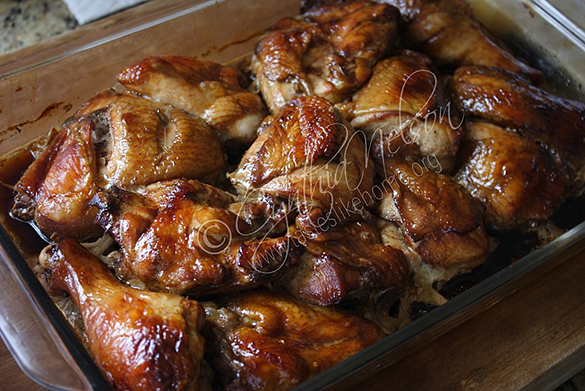 A few years ago, I did a What’s Cooking on Baked Chicken. You know – that series in which I address questions you may have about food and cooking but are too shy to ask. This time it is a reload, so to speak, with added information based on questions that I continue to get about baking chicken.
A few years ago, I did a What’s Cooking on Baked Chicken. You know – that series in which I address questions you may have about food and cooking but are too shy to ask. This time it is a reload, so to speak, with added information based on questions that I continue to get about baking chicken.
Here in the Caribbean, we make a differentiation between Baked Chicken and Roast Chicken based on how they are cooked. Roast Chicken, whether cooked whole, halved or quartered is usually done with dry heat. Dry heat in this case means the food is cooked at a high temperature in the oven without any surrounding moisture such as one would find in a marinade. This type of cooking gives the food a brown crust that can be crisp, which adds flavour. Many meat and poultry recipes call for a roasting rack to be inserted in the baking pan, this is to ensure the even circulation of heat around the roast and avoid a soggy bottom.
Chicken or other meats to be baked are usually seasoned with a marinade that comprises a variety of liquid seasonings in addition to moist pastes and sauces. For example, the liquid seasonings could be soy sauce, oyster sauce, ketchup, browning, Worchester sauce etc. An example of a wet herb paste is green seasoning. This type of cooking is with ‘wet heat’ because of the marinade surrounding the protein as it is cooked in the oven.
These days, Baked Chicken is very much an everyday dish but, on the weekends, we tend to do something a little extra or special with it, mostly with the seasoning – herb pastes, spice blends or a combination thereof. The information most people want is how to bake the chicken so that it makes its own sauce and has an appetizingly rich, brown colour. Too many have had dry baked chicken and then had to glaze the chicken with some type of readymade sauce, such as barbecue when it is done cooking.
Let’s do a deep dive and get you making some delicious Baked Chicken.
Chicken
Chicken has white and dark meat. The white meat is the breast and the dark meat is the thighs, drumsticks and wings. All parts of the chicken are good for baking but some pieces cook faster than others. For example, the breast, especially when boneless, cooks quicker. The reason that the dark meat takes longer to cook is because those cuts contain muscles used frequently during the life of a chicken; they are also the most flavourful parts of the bird.
When a whole chicken is to be cooked, a lot of recipes would advise adding the breast meat later to the cooking process or removing it from the pan/pot earlier than the other pieces of chicken (this is to avoid the meat drying out). However, when baking, especially with a marinade, it is not necessary to do either because the meat is being cooked in a liquid environment that penetrates it, making it juicy and simultaneously creating a sauce.
If you are using a whole chicken, cut it into 12 pieces (that is if you are also using the back of the chicken). The 12 pieces would be the breast halved and each half cut into 2 pieces (4); the thighs and drumsticks separated (4); 2 wings and the upper and lower portion of the back (2). Of course you don’t have to do any cutting if you are using pre-cut chicken pieces.
Should the chicken be scored? Scoring is when you make cuts into the flesh or skin of meat. You can if you want to but if the chicken is cut up into the pieces mentioned above, I would not score the meat. However, if the legs (thighs and drumsticks) and halved breasts are left whole, I would score the meat so that the marinade can penetrate and thoroughly season the meat.
Skin on or off? This is an issue of personal preference. I recommend cooking the chicken with the skin on (particularly the breast pieces) because it helps to protect the meat and keep it moist; when you are ready to eat, simply discard the skin if you like.
Seasoning
Exceptional-tasting baked chicken benefits from overnight or at least 6 hours marinating. The seasonings for baked chicken are wide and varied. Every cook has his or her own special touch to make this dish. It can be seasoned with spices, herbs or a combination of both. Or it can be seasoned with a variety of seasoning sauces or a combination of the seasoning sauces and herbs, spices or pastes. Seasoning sauces refer to various types of soy sauce – regular, sweet, dark; oyster sauce; fish sauce; Worcestershire sauce; Chinese sauce; Maggie seasoning sauce; vinegars, wines, pepper sauce, browning, Cassareep, molasses, honey and barbecue sauce. One of the great things about making baked chicken is that you can use all kinds of seasonings and you never have to worry about what you don’t have because once the meat is well seasoned, you would have a fine tasting dish of baked chicken. Therefore, free yourself from a recipe of ingredients with which to season your chicken, the important thing is to give it the recommended time to marinate – overnight or at least 6 hours.
Baked Chicken gets its rich, deep colour from the seasoning sauces used. As the dish cooks the sauces caramelize. The skin of the chicken with its natural oils bastes the chicken as it cooks, and it also helps in developing colour. There are some sauces that give a richer colour than others – dark and sweet soy sauce as well as Cassareep, molasses and browning. You do not use all the sauces at one time; choose 2 to 4 depending on the flavour and colour you’re after. Having said that, there are certain sauces that go well with baked chicken whether you are using a spice or herb-based seasoning. I find that Worcestershire sauce, regular soy sauce and sweet soy sauce give that umami flavour I’m after with baked chicken. I would use this combo with homemade green seasoning. There are times when I go for an all-sauce marinade made up of a variety of soy sauces, oyster sauce, pepper sauce, and Chinese black vinegar. To be quite honest, each time I make baked chicken it is different, I just go with the flow; sometimes, I open the cupboard and start adding a little of this and a little of that. No measuring is involved.
One key thing to remember is that the seasoning sauces all contain salt so you would need to factor that in when seasoning the chicken with additional salt.
Cooking
Unlike roast chicken where the cooking temperature can be adjusted – high and low – during the cooking period, baked chicken likes to be cooked at a consistent temperature. 350 degrees F is the recommended cooking temperature and baked chicken can take anywhere from 35 to 55 minutes to finish cooking depending on the quantity and thickness of the cuts of meat. If the meat is cut small it will need less cooking time if it’s cut large, a longer cooking time. Bone-in meat will take more time to cook than boneless meat.
Always ensure that your meat is brought up to room temperature before adding it to the oven. This is to ensure even cooking and proper cooking time. If the meat is cold, then it will take longer to cook, and you also run the risk of the outer part of the chicken being cooked and the inner part not fully cooked. It is also important that the oven be preheated before adding the chicken to be cooked.
After the chicken has come up to room temperature, add the meat and all the marinade into the baking dish. The marinade will cook and become the sauce to serve with the chicken. This means that you will need to choose a 2 to 3-inch deep dish to bake the chicken.
It is not necessary to baste the chicken more than once when it is baked, and you can do this during the last 10 minutes of baking. I have heard about people turning the chicken halfway through cooking to ensure that the top and bottom of the chicken browns, this is not necessary but if it is something that you feel you want to do, then by all means, go ahead. It is, after all, your baked chicken. Let me hasten to add also that it is not necessary to cover the pan for part of the cooking time, but again, if it makes you feel comfortable to do so, go ahead but remember to remove the covering at least for the last 20 – 25 minutes of cooking.
Serving
When the dish of Baked Chicken comes out of the oven, let it rest for 10 -15 minutes before serving. You can use that time to baste the chicken with its sauce,if you like. The resting period allows the meat to relax and absorb a little more of the sauce. Allowing the meat to rest impacts on the texture of the meat when eaten.
You can serve the baked chicken in the same dish/pan in which it was cooked or transfer it to a platter and pour the sauce into a bowl or gravy boat. You can make a thick gravy by melting some butter in a pan, adding a little flour and then pouring the sauce into the pan along with some stock, wine or water to make a gravy.
Cynthia









